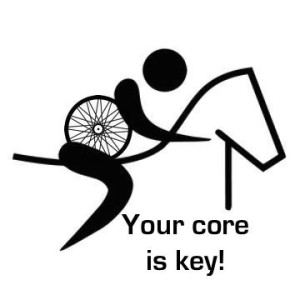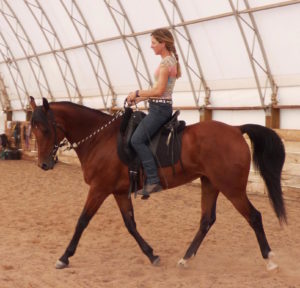Continuing our conversation on Core Fitness, we spoke with accomplished physical therapist, Beth Austin, of Santa Cruz, California. A runner and dancer, Austin rode often as a girl and has an excellent sense of the horse-rider partnership. The therapist and seminar leader works with a wide range of athletes and patients and says, “I have a passion for helping others learn to move in ways that will
keep them active and enjoying their bodies.”
Next week, Katrin Kuenstler, rider and Pilates instructor, discusses her perspective.
Read more about core work from:
Beth Austin writes:
Core strength needs to be dynamic and intelligent. The muscles must learn how to respond appropriately to the information they receive. This is a very particular kind of muscle intelligence that may involve clearing out some neural patterning that has become habitual but also dysfunctional.
Re-patterning is essential. Think of an orchestra: if all the parts know how to tune their instruments and play the full spectrum of their range, they can play anything well with just a little practice. Now consider the many muscles which involve core strength, if we are stuck in a shortening habit (like each instrument being able to play only one note at one volume or timing) it is very difficult to create a new, more graceful, informed movement patterns until the shortened pattern that limits movement intelligence is untangle d and trained out.
d and trained out.
Trying to ride without breaking down your ability to stabilize the center of gravity may not cause too many problems if:
- you are naturally balanced in your body
- you don’t have tissue restrictions that send asymmetrical patterns through you and to the horse.
However, the more we repeat movement patterns, the more we increase the possible detrimental effects of unbalanced movement patterns and the more we turn them into nervous system freeways that are harder to re-route toward balance.
Check out additional articles on neuroscience:
The way many people are “training” their core support can be very detrimental. Incorrect training, however well-intended, may end up compressing the lumbar spine, hips, and limiting mobility range and the ability to respond to incoming information… creating all
manner of real problems for their bodies and their effectiveness as riders, athletes, or just humans.
If lengthening control is incorporated into the strength training and if core muscles and hip flexors are trained into long fluid stability, then the results can make all our body’s movements more easeful and enjoyable.
Check out these Core Exercises here.
Unfortunately, some people may effectively lock themselves up in the low back and pelvis and are core “dumb” even though they can plank for minutes. There is a lot of “bad” core training going on out there where people do sit ups or other exercises that make their center of gravity more rigid. The same is true with pelvic floor: there is so much intelligence to be developed beyond Kegel contractions. Indeed, there is a world of lengthening and non-symmetrical control that is essential for clear communication through one’s seat in riding.
Read more about core work from Beth Watson and Katrin Silva and Amy Skinner.
Reading a fair amount of physical therapy research, I can say our mainstream measurement tools and perspectives come up very short for measuring some of the essential components of core stability. Too often, the training leads to static shortening for activity that requires dynamic strength and responsiveness.
Next week, Katrin Kuenstler, rider and Pilates instructor, discusses her perspective.


Excellent article! Thank you for sharing all these valid insights.